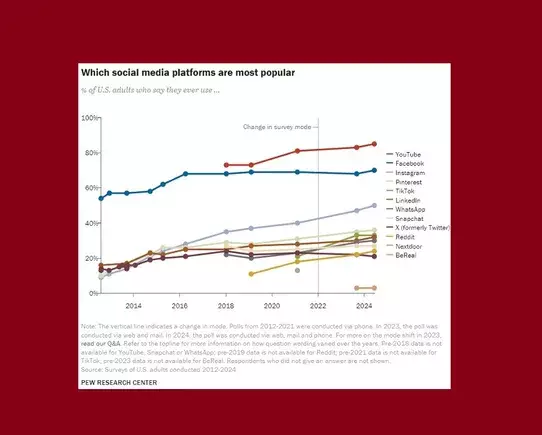The digital landscape is in a constant state of flux, particularly in the realm of social media, where user preferences shift with remarkable speed. Recent research from Pew Research highlights some significant trends in how U.S. adults interact with various social media platforms. This article aims to dissect these findings, focusing on how platforms like X, formerly Twitter, are losing relevance and the enduring popularity of others, such as YouTube and Facebook.
The latest data confirms the undeniable supremacy of video content in social media engagement, with YouTube leading the charge. While the classification of YouTube as a ‘social media app’ may be debated, its capacity to draw in massive user engagement through video remains unrivaled. In the recent survey, a significant percentage of U.S. adults reported using YouTube regularly. This trend signifies a growing preference for dynamic, visual content, which aligns poorly with text-based platforms like X, where engagement often revolves around short-form text and links.
It’s essential to note that Facebook is still a major player, widely utilized across various demographics, especially among older adults. This underscores a critical aspect of social media usage: content forms that resonate with different age groups. As platforms evolve, their abilities to cater to demographic-specific content—like Facebook’s combination of familial sharing and news updates—will likely sustain their relevance in the coming years.
One of the most pressing questions raised by the Pew report is about the waning relevance of X among U.S. adults. While it hasn’t experienced a catastrophic drop in user numbers as some analysts predicted, the incremental decline suggests a troubling trend for the platform. This stagnation can be attributed to several factors, including changing user expectations and competition from more engaging platforms like TikTok and Instagram, which prioritize visual engagement over text-heavy interfaces.
Interestingly, X’s current trajectory contrasts with the steady growth of platforms like TikTok, which, despite recent data showing its user base remained stable over the past year, has been noted for its users’ engagement time. The fundamental reason for this shift could lie in how content is consumed; TikTok’s algorithm promotes a different form of user interaction, prioritizing immersive video experiences that keep users engaged far longer than traditional posts on X.
The Rise of Emerging Platforms
The trends outlined in Pew’s findings highlight the emergence of platforms like TikTok and Snapchat as preferred choices for younger audiences. These platforms facilitate engagement through content that aligns closely with modern consumption habits—quick, visually driven, and shareable. TikTok users, in particular, engage with content that is highly curated and personalized, which sets it apart from the relatively static nature of X’s updates.
It’s also worth mentioning that Pinterest, while not as widely touted as a social media giant, has seen growth in recent times. This hints at the possibility of niche platforms thriving when they cater to specific interests and aesthetics, reinforcing the notion that social media is anything but monolithic.
Implications for Social Media Strategy
The trends emerging from the Pew Research data are critical for businesses, marketers, and content creators as they plan their strategies for the near future. Understanding the demographics that favor various platforms can guide companies in focusing their resources where they will be most impactful.
For instance, targeting content towards the younger demographic on TikTok and Snapchat could yield higher engagement rates than attempting to revitalize an audience on an aging platform like X. On the other hand, established organizations with an older clientele may want to emphasize their presence on Facebook, where traditional engagement models continue to thrive.
As social media continues to evolve, the implications of user preference and platform relevance are vast. The findings from Pew Research illuminate a landscape dominated by visual engagement and a clear bifurcation where age demographics dictate preferences. As brands and creators navigate this shifting terrain, the importance of aligning with audience behavior will dictate their success in capturing attention and driving engagement in a crowded digital space.

